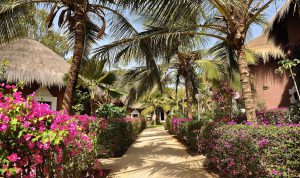Independence date : April 4th 1960(former French colony)
Name of the president : Macky Sall.
Populations : 13 Millions People
Ethnic groups : Around 15 ethnic groups
Major ethnic groups : Wolof, Serer, Peulh or Fulani.
Official language : French Religion: 10 % Christian; 10 % Animists (traditional religion) ; 80 % Muslims.
Main source of income : Fishing, Tourism, Agriculture. Natural resources: phosphats, gold, iron, copper, a little off shore petrol.
Main rivers : Senegal River, Sinesaloum River, Gambia River, Casamance River
Senegal geography: Senegal area is around 200,000sq km. It is limited to the north by Mauritania, to the east by Mali, to the south by the 2 Guineas countries. The country’s western border some 700km is marked by the shore of the Atlantic Ocean, running roughly north-south. About halfway down the coast, the large cap vert peninsula juts out west into the ocean. At the end of this peninsula is Dakar, the capital city with its surrounding suburbs and satellite towns, one of the largest cities in West Africa. To the north of the cap vert peninsula, the coast faces north west and is known as the Grande cote (the great coast) stretching almost unbroken to Senegal’s borders with Mauritania . South of the peninsula is the petite cote (small coast) faces south –west which makes the weather conditions more agreeable for tourism, and this area is among the most popular for visitors. Senegal’s other important geographical features include three major rivers which all flow east to west from the Fouta Djalon highland in neighbouring Guinea Conakry to the Atlantic ocean. In the north is the river Senegal which forms the border with Mauritania. Saintlouis the old capital city is at this river’s mouth. In south -eastern Senegal, the river Gambia flows through park national of NIOKOLOKOBA (913,000ha) before entering the country of Gambia itself. In the far south is the river Casamance, which gives its name to the surrounding Casamance area, a fertile zone of forest and farmland. You will find here Senegal’s most beautiful beaches. Another major river is the Saloum River which enters the ocean via a large delta to the south of the petite cote. Senegal’s country is largely flat with a natural vegetation of dry savannah woodland. Its lies at a latitude between12 and 17 degrees north of the equator at the western end of the Sahel.
Climate: Senegal and Gambia have 2 seasons: A dry season: from October to June. (Warm temperatures: 20 to 35° in daytime, the night is cooler) A rainy season: from June to September ;( warm and wet temperatures: 25° to 40° in day time. The rainy season is characterised by short sharp tropical rain showers. After rain the weather remains always sunny and at night it’s cooler. The landscape is greener and wonderful. So SENEGAL and Gambia offer summer like holidays all the time. The coast remains always cooler thanks to the alizes (breeze blowing all over the year on the coast.)
Time: Senegal and Gambia belong to the Greenwich Mean Time zone with no time changes.
Health: No vaccinations are obligatory. However vaccination against yellow fever and malaria prophylactic are definitely recommended.
Visa: Now all foreign travelers to Senegal can obtain a free of charge tourist visa at any Senegal consulate and Embassy.Us Citizens and European Union citizens can get their free of charge tourist visa upon arrival to Dakar airport.
Feel free to contact us for any help about your visa to Senegal.
Feasts: we celebrate Muslim, Christian feasts as well as traditional feasts. National sports: wrestling
Gambia: Our neighbouring country is smaller (11 000 sq, km)
Population: around 2 millions people
Ethnic group: the same as in Senegal (most people speak mandica, English and local dialect)
Official language: English (Gambia was a British colony)
Main source of income: agriculture, tourism, fisheries.
Gambia geography
Gambia’s national boundaries are carved by the European colonial powers at the end of the 20th century. About 300km long, but averaging only 35 km wide and is entirely surrounded by Senegal, except for about 80km of coastline. The country’s territory is determined by the river Gambia which flows into the Atlantic Ocean, dividing Gambia into northern and southern section. Banjul, the capital, is on the southern side of the mouth of the river Gambia.West of Gambia is the holiday resorts and the center of Gambia’s tourist industry.
Like Senegal, Gambia is a flat country.





